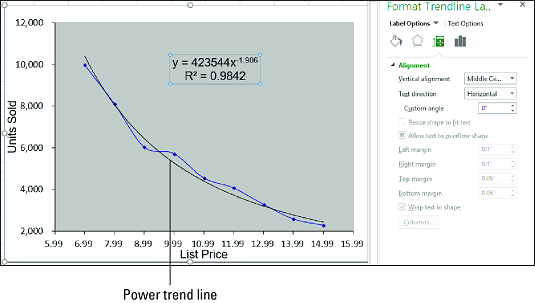

Trendlines.Count returns a Long value that represents the number of objects in the collection. Type returns or sets an XlTrendlineType value that represents the trendline type. Period returns or sets the period for the moving-average trendline.
EXCEL TRENDLINE INTERCEPT 10 SERIES
In the Add Trendline dialog box, select any data series options you want, and click OK. Order returns or sets a Long value that represents the trendline order (an integer greater than 1) when the trendline type is xlPolynomial (XlTrendlineType). Binary option 10 Excel trendline equation is wrong - reasons and fixes Excel trendline types When adding a trendline in Excel, you have 6 different options to choose from.

NameIsAuto true if Microsoft Excel automatically determines the name of the trendline. Name returns or sets a String value representing the name of the object. A new dialog panel will show up to the right. (Sometimes you might need to click twice.) Click on Format Trendline Label from the options that appear. InterceptIsAuto true if the point where the trendline crosses the value axis is automatically determined by the regression. In the latest version of Excel, however, you can change the number of digits displayed in your fit by doing the following. Intercept returns or sets the point where the trendline crosses the value axis. Index returns a Long value that represents the index number of the object within the collection of similar objects. Setting this property to True automatically turns on data labels.įorward2 returns or sets the number of periods (or units on a scatter chart) that the trendline extends forward. Setting this property to True automatically turns on data labels.ĭisplayRSquared true if the R-squared value of the trendline is displayed on the chart (in the same data label as the equation). Propertiesīackward2 returns or sets the number of periods (or units on a scatter chart) that the trendline extends backward.īorder returns a Border object that represents the border of the object.ĭataLabel returns a DataLabel object that represents the data label associated with the trendline.ĭisplayEquation true if the equation for the trendline is displayed on the chart (in the same data label as the R-squared value). Trendlines.Item - Returns a single Trendline object from the collection. Trendlines.Add - Creates a new trendline. Dim trnln As Trendlineįor Each trnln In ActiveChart.FullSeriesCollection(1).Trendlines()ĬlearFormats - Clears the formatting of the object. Here is an example of processing the Trendline items in a collection. The following procedures can be used to set variables of type Trendline: Trendlines.Add and Trendlines.Item. Set trnln = ActiveChart.FullSeriesCollection(1).Trendlines(Index:=1) To use a Trendline class variable it first needs to be instantiated, for example Dim trnln as Trendline In the first example, the line graph had only one data series, but the following column chart has two.The class Trendline represents a trendline in a chart. We’ll explore more of these later in this article.Ĭhoose the trendline you want to use from the list, and it will be added to your chart. Obviously, you can also export your data set to Excel to do the. The Format Trendline pane opens and presents all trendline types and further options. This visual will give you the equation (Y MX + B), R2, and other regression output data.
EXCEL TRENDLINE INTERCEPT 10 FULL
To see the full complement of options, click “More Options.” It uses a specified number of data points (two is the default), averages them, and then uses this value as a point in the trendline.

To understand how Excel calculates INTERCEPT we need. The line is more curved than a linear trendline. To calcualte the y-intercept in excel, we use Excel INTERCEPT function.

There are different trendlines available, so it’s a good idea to choose the one that works best with the pattern of your data.Ĭlick the arrow next to the “Trendline” option to use other trendlines, including Exponential or Moving Average.


 0 kommentar(er)
0 kommentar(er)
